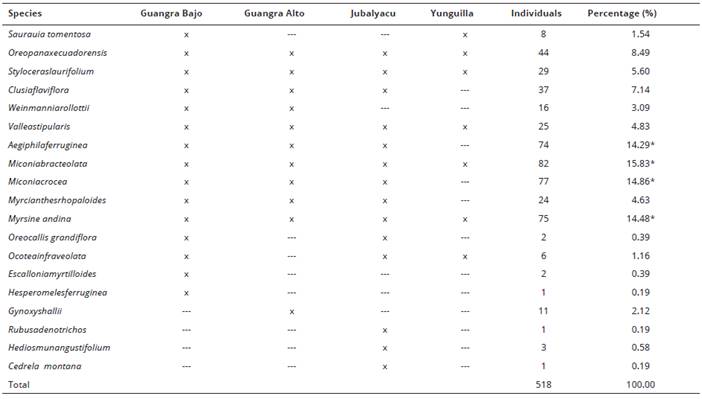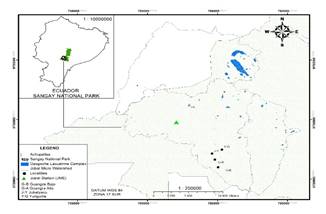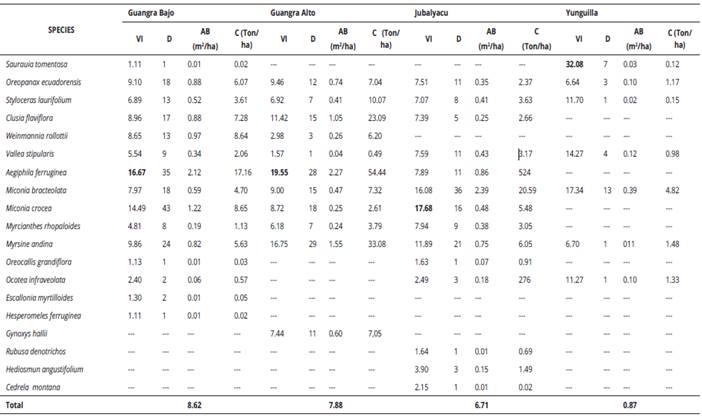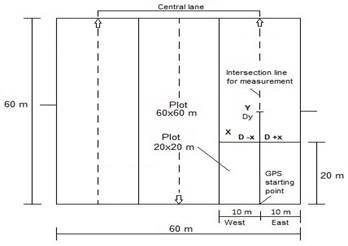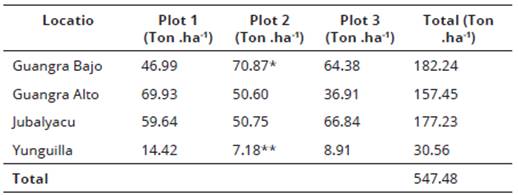Introduction
The floral diversity constitutes an important feature of the ecosystems, because of its implications in the species conservation and its role in the ecosystems function (Hooper et al., 2005). Generally, the plant diversity increases the efficiency of resource use and contributes to stabilize the ecosystems functioning (Perea, Guardia, Medina, & Hinestroza, 2013). However, due to the low number of taxonomic and systematic studies oriented to know the diversity and one of the main changes that currently affects is the high rate of deforestation of natural ecosystems, existing a substantial loss risk of the biological diversity before it can be described, recorded or monitored.
Ecuador is one of the 17 mega-diverse countries of the world, it has an infinite variety of plants species, animals and microorganisms, due to its privileged geographical location in the neotropics, its different highlands and the marine currents influence, converge to build the scenery of the most varied forms of life, genetic diversity and ecosystems. This global biodiversity underpins the ecosystem functions, essential for life on Earth, such as water, soil conservation, carbon fixation (C) and climatic stability, besides it provides products such as food, medicines, industry materials and natural deposit of seeds constituting itself this way in an enormous potential for the conservation and management of natural resources (Martini, Fiaschi, Amorim, & Da Paixão, 2007).
In the Neotropical ecosystems, the altitudinal stripe of the moorlands and the interaction of factors such as precipitation, altitude and latitude (Cargua, Rodríguez, Recalde, & Vinueza, 2014), make the Andean brow forests be distributed along the inter-Andean alley which correspond to the transition zone between the moorlands and the temperate forests, belonging to the ecoregion and hotspot of the tropical Andes where the plant biodiversity is varied and heterogeneous, because of the fact that it contains a greater number of habitats and species. Forests are one of the main ecosystems where the highest percentage of C is stored, in both aboveground biomass and soil (Polo, Vázquez, & Flores, 2011), by means of natural procedures that can be accumulated for several years (Fonseca, Benayas, & Alice, 2011). In the same way, the diversity indices are the development opportunities indicators that have organisms in an area (Alvear, Betancur, & Franco-Rosselli, 2010). The present research aims at characterizing the biodiversity of the stratum of the Andean brow forest and to evaluate the representatively thereof as potential to capture the C, taking into account the variation among altitudinal floors and the vegetation state.
Materials and methods
Study Area
The monitoring spots are located at the top of the micro-watershed of the Jubal river, in the Guangra community, parish of Achupallas, area of influence of the Sangay National Park, according to its morphometry, the micro-watershed has a wide altitudinal unevenness 2705 m. a. s. l., an important feature for the development of a variety of life zones. Due of the elongated shape, the main channel and its tributaries tend to be straight, implying greater speed of runoff and the hauling of sediments (Table 1).
The soils of the sector are Andisols, formed by fresh volcanic ash with a sandy loam texture, granular structure, with black color by the presence of a large amount of organic material, stoniness <5 % and an apparent density average of 0.49 g. cm-3. The implementation of the permanent plots was performed by taking into consideration the type of vegetation cover, which for the present study, corresponds to the Andean montane evergreen forest (AMEGF), with an approximate surface of 11052. This forest fragment is distributed altitudinally from 2400 to 3400 m. a. s. l.
The vegetation cover in this area is characterized by dominant tall species as follows: Myrsine andina, Miconia bracteolata and Clusia flaviflora, reaching heights greater than 15 m, which are covered by epiphytes plants (mosses, lichens, algae and ferns); in stratum of understory it was found own species of regeneration that will lead to new individuals (Table 2).
According to the data of the Meteorological Station located in the community of Jubal (M 5138), UTM_756205 East and 9734269 North, at an altitude of 3462 m. a. s. l., the average temperature of the sector ranges among 3.4 - 12.7°C, an average precipitation of 1077 mm, with ranges of (1000 - 1200) mm and a relative humidity of 83.6% with ranges among (43.9 - 92.2) %. (Table 1).
Sampling
A sampling design of double stratification was applied, which consists of two phases. During the first phase a large sample was selected in a systematic way throughout the forest of this sector, this sample helped to estimate the size or weight of the stratum in relation to the population and the sample. In the second phase, a smaller sample was selected for the stratum of the Andean montane evergreen forest (Figure 1), (Table 3). (Cave et al., 2012).
Stratification of sampling units
For field evaluations, was implemented four conglomerates (C) 3 plots (P) in the shape of "L" with a dimension of (60 x 60) m. and a distance among plots of 250 m, (Figure 2).
These plot provision is usual to take biomass measurements in most vegetation types (Ravindranath & Oswald, 2008), in each selected sample a forest inventory was conducted where all variables of interest were measured and observed (DBH, total height, basal area, volume). The plots were divided into three bands, in the band one the sub-plot of 20 m x 20 m was installed, where the trees with DBH ≥ 5 cm were measured. Of the 20.1 m to 60 m, the trees with DBH ≥ 10 cm were measured, as in the bands 2 and 3 (Figure 2). The distance in Y (Dy) is determined for the trees spatial location which gave us values among 0 m to 60 m, to measure the perpendicular distance of the center lane toward the tree, distance in X (DX) with values among 0 m to 10 m. Toward the right side positive values were obtained (+) and negative to the left (-). Similar procedure performed in the bands 2 and 3. The diameter was measured with the diametric tape on the crust at 1.30 m at chest height (DAP), the height of the tree was measured with the SUUNTO hypsometer with precision of the distance measurement ± 0.5 m for the biomass calculation was required to measure the total height. The calculation of the total basal area and total volume was performed. However, this is a primary forest considered for environmental service.
To determine the content of aboveground biomass were employed shaft expansion factors, stem plus treetop 2.8; coefficient performs the volume or actual stocks from the forest inventories to estimate biomass and C, (Chávez-Pascual et al., 2013) (Table 4).
These expansion factors are utilized to obtain an estimate of biomass of trees including all of its components and it is usually used the multiplication of the basic average density by the volume of each tree, avoiding in this way the destructive method and the high costs that generate this type of analysis. Throughout these studies, have allowed to generate useful information which constitutes an important basis when estimating the capacity of fixation of C in a forest. For the data quantitative and qualitative analysis, the following variables were calculated according to each Forestry species: Density (D), basal area (AB in m2.ha), frequency (F), Simpson, Shannon and the importance value of species (VI), define which of the present species contribute in the nature and structure of an ecosystem. This value is obtained from the sum of the relative frequency, relative density and relative dominance. (Equations 1, 2 and 3).
The structural analysis of the forest for each plot by locality was based on the relative importance value (VI) of each species. The basal area (BA) was obtained with this relation (Equation 4):
The Simpson diversity index (SDI)
It expresses the probability that two individuals, who are randomly taken from a sample, can be the same species. This is strongly influenced by the importance of the most dominant species (Equation 5).
Where:
D= Simpson index
S= Species number
Ni= total number of present individuals, i, with respect to the total of individuals (that is to say the relative abundance of the species)
N = number of individuals per species
Shannon diversity index
It expresses the uniformity of the importance of values through all the sample species. It measures the average degree of uncertainty in predicting to what species an individual chosen at random from a collection will pertain. It assumes that the individuals are selected randomly and that all species are represented in the sample. It acquires values between zero, when there is a single species, and the S logarithm, when all species are represented by the same number of individuals (Equation 6).
Where:
H' = Shannon index
S= Number of species
Pi= Proportion of individuals of the species i with respect to the total of individuals (that is to say the relative abundance of the species i).
Results and discussion
The Evergreen forest of Andean brow (BSVCA), is distributed in an altitudinal range among 1500 and 4000 m. a. s. l., the canopy of trees is among 10 and 15 meters high. The most dominant species are: Saurauia tomentosa, Oreopanax ecuadorensis, Styloceras laurifolium, Clusia flaviflora, Weinmannia rollottii, Vallea stipularis, Aegiphila ferruginea, Miconia bracteolata, Miconia crocea, Myrcianthes rhopaloides, Myrsine andina, Oreocallis grandiflora, Ocotea infraveolata, Escallonia myrtilloides, Hesperomeles ferruginea, Gynoxys hallii, Rubus adenotrichos, Hediosmun angustifolium and Cedrela montana. This type of vegetation is characterized for being a transition zone among the montane forest and the moorland. Currently the Andean brow forest is present as shaped islands of natural forest (fragments or patches) relegated to the ravines, or in lands with steep slopes. The flora richness in this type of montane forest is given by the presence of herbaceous, shrubs and epiphytes species (Cargua et al., 2014). (Table 5).
The forest inventory recorded in the four localities registered 17 families, 18 genres, and 19 species, where Miconia bracteolata is one of the species with the greatest number of individuals (82), that represents the 15.83% of the total of analyzed individuals, it is present in both primary and secondary forests its growth is fast in relation to other species of Andean brow forest, it shows ideal features for the construction of houses in the sector, Escallonia myrtilloides is a species that is present in the Guangra Bajo sector it is in danger due to the deforestation, its characteristics and quality of the wood are determining factors for its exploitation. The registered species are not listed in the red book of the endemic plants of Ecuador (León-Yánez et al., 2011). In the province of Chimborazo, it is registered a total of 2038 shrub and tree species, representing 13.30%, nationwide, of which 37.6% was recorded in the locality.
The species of greatest importance value (VI) in the area are: Aegiphila ferruginea present in the localities of Guangra Bajo and Guangra Alto, Miconia crocea in the locality of Jubalyacu and Saurauia tomentosa in the locality of Yunguilla. The parameter that greatly contributes to the importance of the majority of species is the basal area due to the fact occupies more physical space and controls in a high energy percentage that arrives directly to this type of ecosystem. The presence of species with a lower importance value in the study area was due to the fact its structure is more sensitive to human and environmental disturbance.
In the study area, the species serve as natural indicators to know the forest state, furthermore its seeds are the main food of a large number of birds, insects and rodents. These forests are the key to maintaining the balance in the hydrographic watershed due to capture from 5 to 20 % of the normal volume of precipitation (Pompeu et al., 2014). The species with the highest density was Miconia bracteolata (n = 82), followed by Miconia crocea (n = 77), Myrcine andina (n = 75) and Aegiphila ferruginea (n = 74). The basal area values by species were calculated based on the minimum diameter of measurement for this forest type (≥ 5 cm), as it was expected this parameter reached the maximum values in the locality of Guangra Bajo, followed by Guangra Alto, Jubalyacu and Yunguilla (Table 3).
Therefore, there are factors which influence the flora diversity development as follows: temperature, precipitation, solar radiation, humidity, altitude, latitude, longitude. These influence for some developing species tend to be more dominant, because of its high capacity of adaptation to the environment conditions. Throughout the variance analysis, the existence of significant differences between biodiversity (percentage of individuals) and its biomass (carbon content) was determined, finding (F = 4.23; P value = 0.04), this occur mainly because all the species are not encountered in the different strata (Tables 3 and 4).
For this research, the altitude is considered as the main parameter and in this regard (Jiménez, Pauchard, Marticorena, & Bustamante, 2013), found at higher altitudes, there is a lowest number of wild plant species. Likewise, (Montesinos-Tubée, 2011), finds a higher richness of species in plant formations of lower altitude. The floristic composition did change in relation to the elevation, since families, genders and species appear and disappear along the gradient.
The total of C stored in the aboveground biomass in Guangra Bajo was (182.24 ton. ha-1), because of its high diversity (0.85). Of the total number of individuals registered in the twelve plots Aegiphila ferruginea is one of the species which stores more the aforementioned element (47.66 ton. ha-1) and the lowest value (30.56 ton. ha-1) it is presented in the Yunguilla sector for its average diversity (0.71). However, different studies denote the variability of C content according to species and the tree tissue. In addition, the content of C in the tree biomass corresponds to the 50% which is influenced by the quality of the site in which they grow.
According to the Shannon index, the diversity is high in the four areas, Guangra Alto, has the greatest diversity with 0.93 of average and the lowest level is in the locality of Jubalyacu with an average of 0.88. For the Simpson index, the diversity is high in the Guangras Bajo area (0.87), Guangra Alto (0.86) and Jubalyacu (0.84) and middle in the Yunguilla area (0.71). According to (Garcia et al., 2010). The diversity results are in the range between 0 and 1.0, which represent a situation in which all species are equally abundant, the diversity index is usually located among 1.5 and 3.5 and rarely surpasses 4.5 and can be established three plots, which have allowed to establish a high heterogeneity with the exception of the Community of Yunguilla, which is medium.
Conclusion
In total, it was identified 19 forest species with 518 individuals of which the predominant family was Melastomataceae which belongs to the Miconia gender with 159 individual equivalent to 30.70%. The highest concentration of C present in the above-ground biomass is recorded in the Guangra Bajo area (182.24 ton. ha -1), these values are associated with high biodiversity of Shannon species (0.90) and Simpson (0.87), the lowest values of C in the above-ground biomass are presented in the Yunguilla sector (30.56 ton. ha -1), and the biodiversity indices: Shannon (0.89) and Simpson (0.71). The altitudinal ranges vary among 3300 - 2700 m. a. s. l., the presence of the adapted species to these physiographic units has not reported. This information is important because this group of plants can be used as an indicator of the conservation state of this type of forests which are in danger of disappearing and become an important reason to take into account when focusing on mitigation measures against the climate change.














